When it comes to residential home services, reviews (e.g. plumbers reviews, electricians reviews, roofers reviews, etc.) hold a significant amount of sway with prospective customers.
There are a ton of distinct services, skill sets, and home service professions. Each home service professional’s business has a certain uniqueness when it comes to client expectations through the vetting stage.
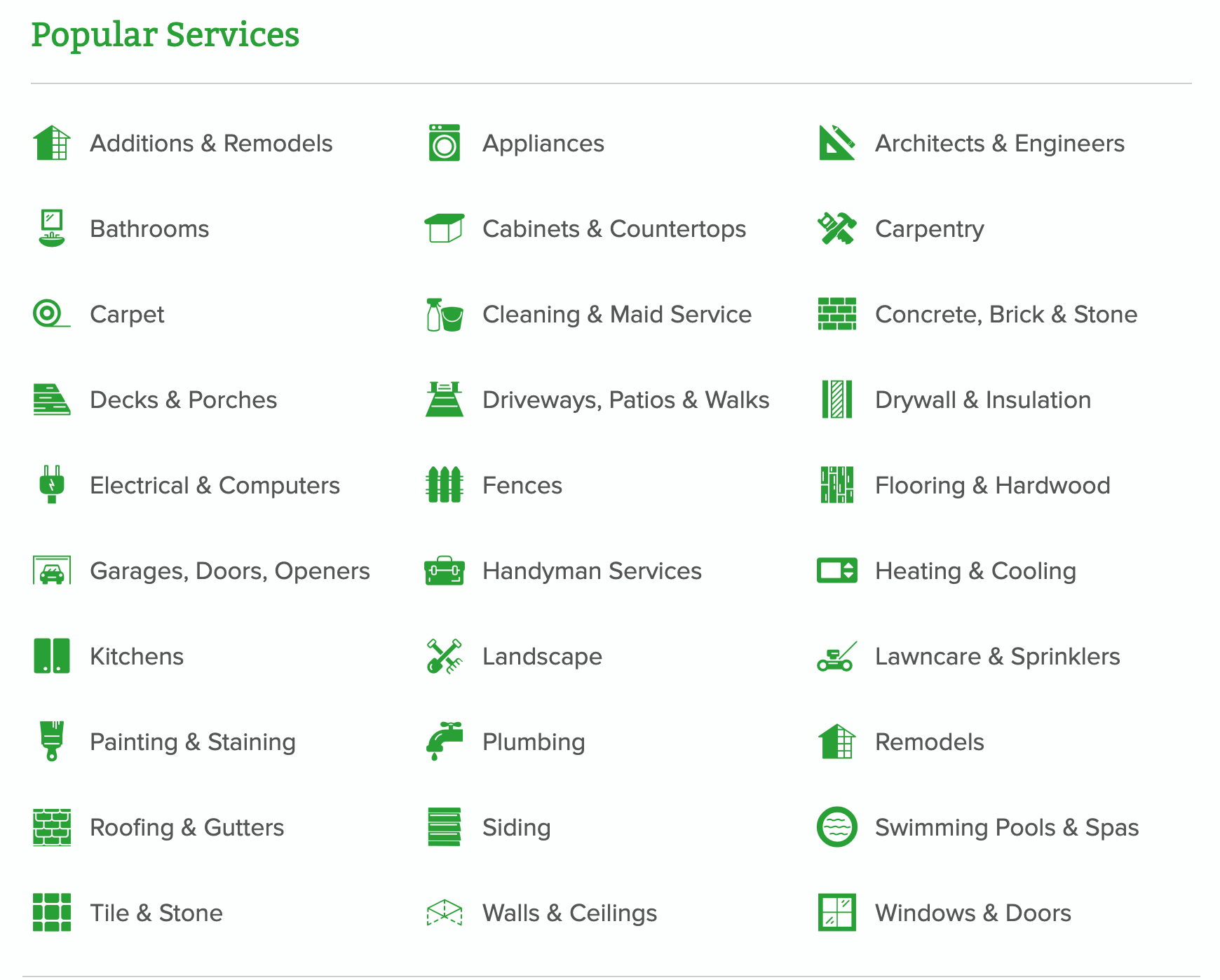
Just look at this list of popular home services on Angie’s List.
There are also a ton of commonalities between specialties when it comes to finding new clients. As a home services provider, you’re in a tough spot.
When customers request a bid, they expect you to provide rock-bottom pricing. You’re routinely forced to compete with a bizarre mix of competent and incompetent home service professionals, each one doing their best to offer the lowest price.
Your customers can’t tell the difference between them, so they use price as the determining factor.
Sure, pricing is important, but it stops mattering if the professionals you’ve hired produce shoddy work. What does this mean? There are other factors customers value more, or at least as much as price.
Why your home services reviews are so important
A report from Software Advice, a technology firm that analyzes how customers use software, shared key insights on home services reviews:
If you’re an experienced home service provider, you’re well aware of the dramatic impact a strong home service review portfolio can make on your business. What’s more surprising is item number two – 86% of customers are willing to pay more for providers with higher ratings and reviews.
The question is, how much more?
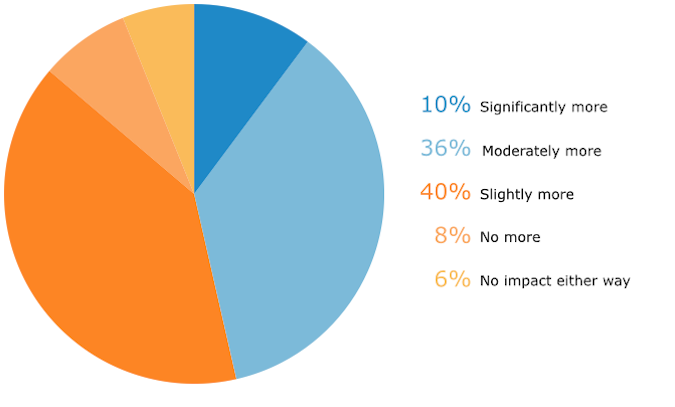
Very exciting stuff!
So, 46%, a little less than half of your customers are willing to spend moderate to significantly more money if you have the reviews. Get your existing customers to vouch for you and you win.
Home service reviews are something every provider has, right?
Wrong.
Why home services providers struggle to win customers
Many providers today have online reviews. What most don’t have is a strong, balanced review profile. When it comes to online reviews, there’s a significant provider divergence. There are a few providers who get it. They have a strong review profile, and they are working consistently to improve their portfolio.
These providers are the exception, not the rule.
A quick scan of providers shows most are struggling with one or more of the following problems.
Why are these details so important?
Competitors.
You’re dealing with different kinds of competitors.
1. Local competitors: These are the people you compete with (in your town, city or state) regularly. I assume most providers understand this so I won’t spend too much time on the competitors in this category.
2. Large competitors: These could be large regional or national brands or home service franchises (i.e., Roto-Rooter) with a significant amount of name recognition. A strong review portfolio is one of the easiest and most effective ways to compete with a large, well-established competitor.
3. Look-alike competitors: These are the competitors with similar names (or brands) to yours. They’re also a serious problem for providers with poor review portfolios. Providers with poor local search and review management practices may be their look-alike competitor! Customers often use aggregate reviews and local data to weed through the initial list of providers they’re considering.
Here’s an example.
This company has a Yelp profile they’ve claimed. But they have zero reviews.
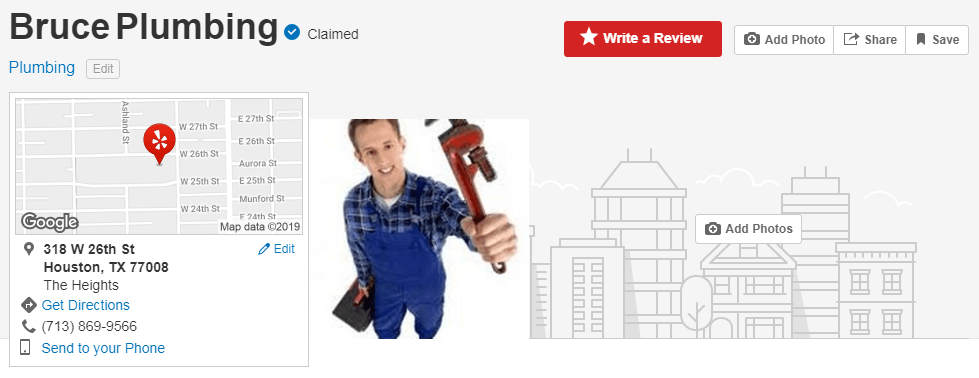
Here’s what I get when I search for their business on Google.

See the problem?
The keyword I used is “Bruce plumbing Houston Texas.” If we take a closer look at these search results, a few things stand out:
These search results may be referring to the same business, but there’s nothing official to indicate that. If I were a potential customer, I’d be very confused right now. These two providers could be amazing, but I have no way to tell. What’s worse, they don’t have much in the way of online reviews. It’s easier to disqualify them from consideration and move on.
I get it, that sounds harsh.
But it’s also the reality your customers face when they put potential candidates through their vetting process. Why take the time to sort through these issues when they can work with the provider with clear information and better reviews?
4. Fly-by-night competitors: These providers aren’t true competitors. These providers are viewed as uncertified, incompetent bottom feeders. They use lowball pricing and unrealistic promises to steal business from you. These providers take money from good customers and opportunities from you. They deliver shoddy work; then they move on to the next town.
A strong review portfolio protects your business from these fly-by-night operators. Your portfolio also protects your margins. You’re able to compete with lowball estimates, bringing in more revenue than your competitors.
See what I mean?
This is why your review portfolio is so important to your business.
Why though?
Why are online reviews so important to the home services industry? Why would reviews create such a strong competitive advantage?
The home services industry has a reputation
We’re all aware of the industry’s reputation. Specific segments in the home services industry have a poor reputation. All thanks to a few fly-by-night operators who consistently work to undermine and destroy customer trust.
Customers are understandably cautious.
Some segments (roofing) are more problematic than others (plumbing and electrical work). Customers are afraid of nightmare scenarios like these where low-cost providers promise the world but deliver disaster. In the video below, a plumber causes a major flood in an apartment building due to negligence.
It’s your customer’s worst fear.
It’s also why customers focus their attention on your online review portfolio. Reviews are a reliable way for them to avoid expensive disasters like these.
Here’s how these customers search for home service providers online. If they’re searching Google they may see results like these:
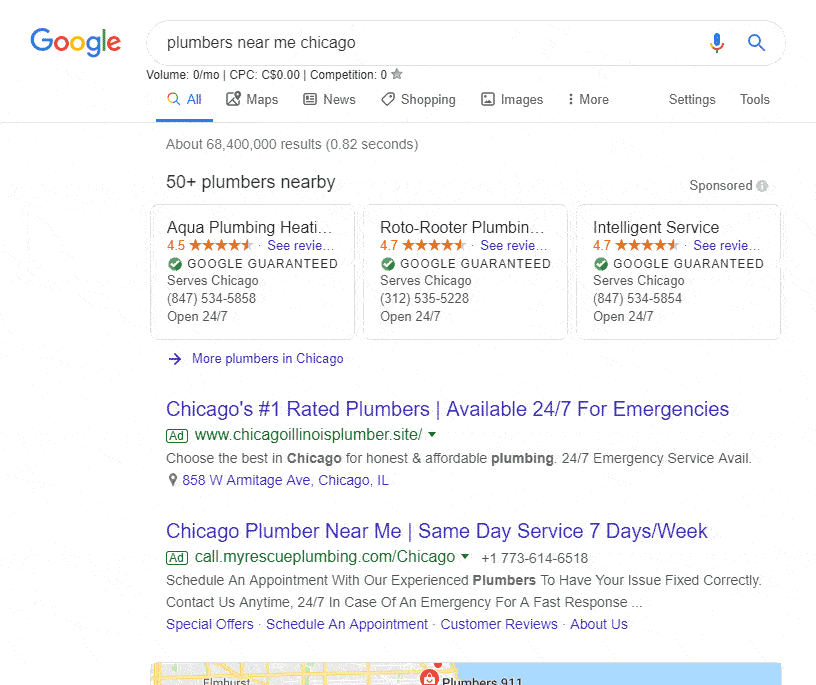
If customers are searching on Yelp, they may see this:
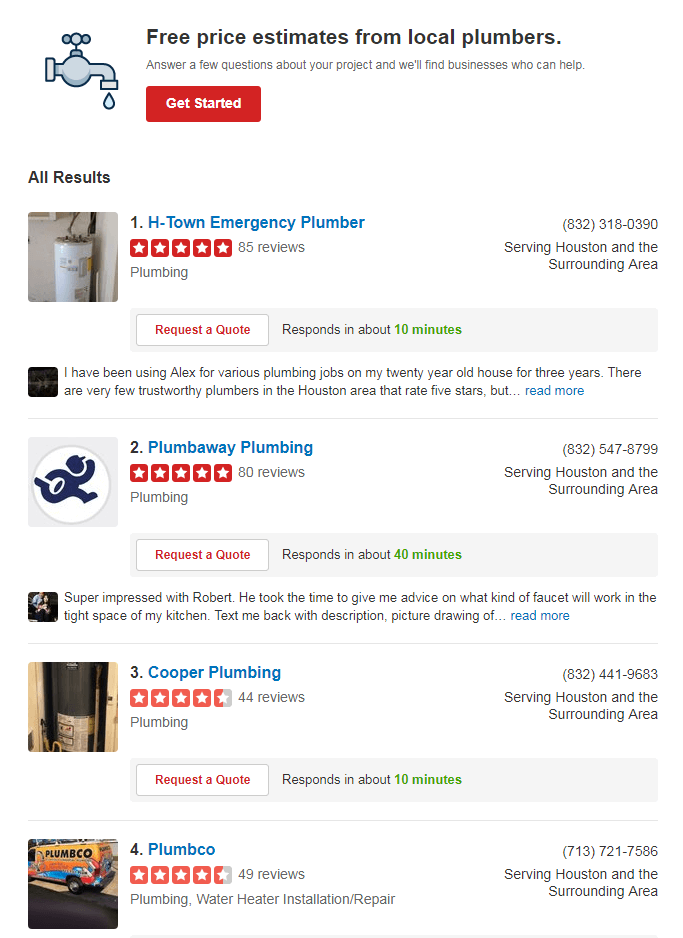
What about Angie’s List?
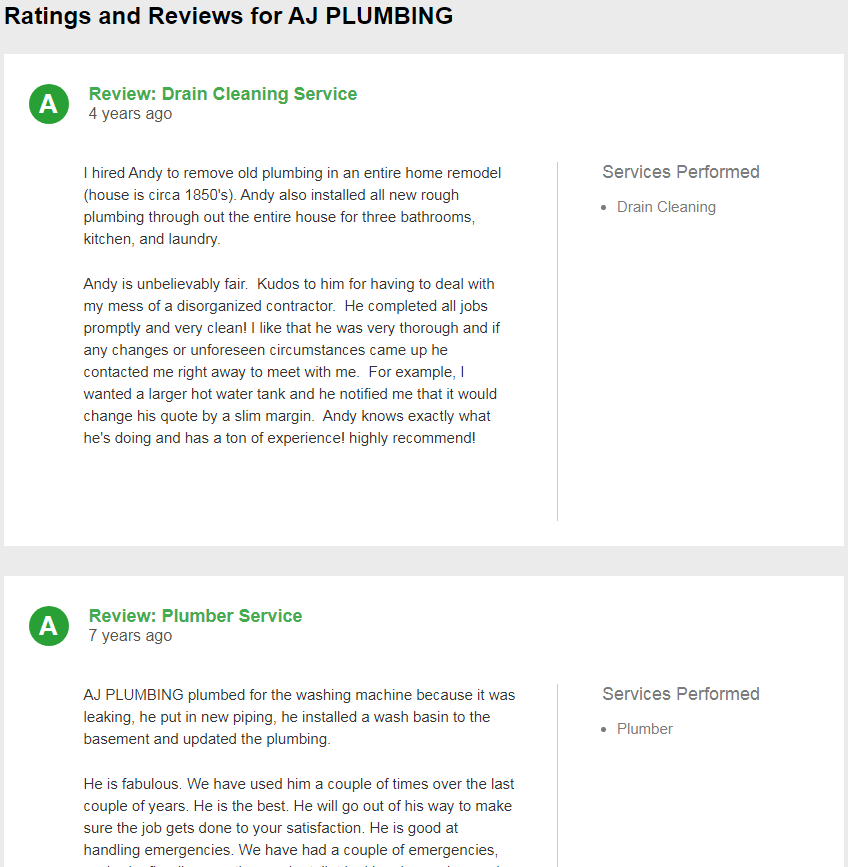
First, let’s take a look at local search keyword data. When we run the query “plumbers near me” through keyword tool.io, we see a nice list of keywords that customers are already using. Let’s take a look at a small sample.
We also see the standard modifiers used with additional keywords.
When we analyze this closely, some interesting details begin to stand out. We see that customers are looking for very specific information. They want plumbers…
This list is the key to optimizing your website, local, review and social media profiles. These keywords give you the inside track to your customer’s desires and intent. Here are some straightforward ways to use these keywords in your marketing.
Here’s the good news about these strategies and tactics. They’re simple, straightforward avenues you can take to convert more of the customers you attract. The bad news? It takes time for these strategies to produce results.
What if you need customers now?
A Six-Step Process To Generate Leads Quickly
1. Create and claim your review profiles
You’ll want to create or claim your review listings on mainstream sites like Google, Yelp, Facebook, and other industry-specific sites like Home Advisor, Angie’s List, or Houzz. Use the intel you’ve taken from your keyword data to optimize your home services website, local, review and social media profiles.
2. Create a compelling value proposition
Your value proposition answers one specific question. Why should I hire you for my contracting opportunity, specifically? It has four essential ingredients. Appeal (I want it), exclusivity (can get it anywhere else), clarity (I understand you) and credibility (I believe you). This is the most difficult part of the process. Stick with it until you’ve created a compelling value proposition that includes all four ingredients.
3. Create multiple irresistible offers
An irresistible offer provides your homeowners and property managers with the overwhelming incentive they need to take action on your offer.
Examples include discounts (15% off your first house call), bonuses (a one-time free pest control treatment), vanishing or limited offers (be one of the first 10 callers and you’ll receive…), guarantees (in-budget, on-time scheduled service appointments or your money back).
Create an irresistible offer for both your customers and tangential sources. Post your value proposition and irresistible offers (for customers) on the profiles you’ve created or claimed. You can share these details in your descriptions, as image snippets, or links to specially tailored, offer specific landing pages on your website. Be sure to include the keywords you’ve identified in your research.
4. Partner with complementary or related businesses
Find (and meet with) other home service providers (electricians, HVAC pros, engineers, general contractors, roofers, etc.) tell them you can resurrect their dead leads, that you can put 40% to 60% more money back into their pocket, without any additional effort on their part.
5. Resurrect their dead leads
Ask each of these professionals to share a list of their dead leads, prospects they’ve contacted in the past but failed to close for one reason or another. Tell them you’d like to help them close these lost customers. Let them know you’ll do all the legwork, keep them updated on your progress, and alert them when it’s time for them to step in and help you close the sale.
6. Create a resurrection sequence
A resurrection sequence is nothing more than a follow-up sequence that’s designed to grab and hold the attention of an inactive prospect. Your resurrection sequence has a specific set of details included in each message
1.) An irresistible offer
2.) An urgency trigger or incentive to act now
3.) A clear and unmistakable way for these prospects to opt-out
Your communication should include these three ingredients regardless of the channel used (e.g., email, text message, phone call, social media, etc.).
Combine this six-step process with the marketing ideas I’ve mentioned earlier. The more interested these customers are, the more of your attention they earn.
Here’s an idea you can use to jump-start this process.
Feel free to customize each of these details as needed. Create your plans or work to mix and match each of the ideas I’ve shared so far.
All of this depends on your ability to earn five-star home services reviews
How do you earn five-star home services reviews?
It’s easy. You ask.
Research from BrightLocal’s annual survey shows 70% of customers will leave a review for your business if you ask them to. That’s the problem though, isn’t it? How do you go about asking customers to leave a review? The whole thing seems a bit – awkward.
Here are two templates you can use:
Subject: [Customer Name], we did it together! We finished [on-time and in-budget]
Wow [Customer Name],
It was challenging but we were able to finish your [type of work] project on-time and in-budget. We’re happy if you’re happy!
Would you be willing to share your story on [review site]? It helps us grow, but it also helps customers like you.
Here’s a link that makes it as easy as possible:
[Review Funnel Link]We’re thankful for you either way,
[Signature]Text message: [Customer Name], did we make you happy? Would you be willing to share your story on [review site] either way? [Review Funnel Link]
Here’s another template you can use.
Subject: [Customer Name], you’re a…
[Customer Name], you’re amazing.We’ve finally finished our work together. I wanted to take the time to thank you before we wrap things up. Thank you for [praiseworthy detail].
You’re an absolute pleasure to work with.
Would you be willing to share your story with other customers just like you? We’d be grateful for your help and support.
If you’re interested, you can share your story here:
[Review Funnel Link].Thanks again,
[Signature]Text message: [Customer Name], you’re a pleasure to work with. Would you be willing to share your story with our other customers? [Review Funnel Link]
Okay, we’ve made some progress. Customer reviews are beginning to roll in. Some reviews are positive, others negative. Who should be in charge of these new reviews that come in?
Here are some general guidelines you can use to determine who should be in charge of reviews.
If you’re running a small business, the owner or general manager of the business should act as the first responder. They’ll have the authority to make decisions on the customer’s behalf. But they must have tough skin. If they prefer to blame, lash out or provoke reviewers, they’re the wrong person for the job.
What about monitoring your reviews?
If you’re taking the manual approach, most sites allow you to set up alerts for the review sites. Here are some instructions outlining how you can set notifications for the big three.
You want to use review platform like REVU4 to monitor niche, specialty and industry-specific sites like Houzz, Home Advisor, Angie’s List, the BBB and more.
Home service providers tend to compete on price
There’s no reason you have to do the same.
Many providers today have online reviews. What most don’t have is a strong, balanced review profile. The vast majority of providers are struggling with no reviews, too many reviews or a review imbalance. Then there’s the list of competitors chipping away at your business.
Your competitors + a poor review portfolio = significant loss of business.
The research from Moz is clear. Increase the number of aggregate reviews listed in Google’s search results and you increase the number of leads, customers and sales your business brings in. It’s all about building a strong, balanced and comprehensive review portfolio. Do it and you’ll find the majority of your customers are able and willing to spend more money with you.
Len is the owner and Creative Director of Quiet City Design, a full-stack media marketing company based in Toronto, Canada. He is passionate about helping his clients leverage the internet to improve business online and offline. Those methods include website development and digital marketing as well as online review reputation management and online scheduling and appointment booking platforms for local business owners.

